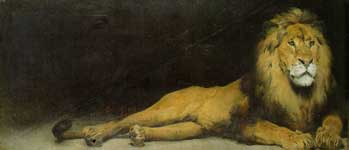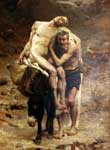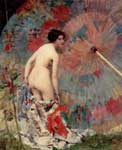Aime Nicolas Morot
Paintings , Drawings
Two Tigers Fighting



Aimé Nicolas Morot (1850–1913) was a French painter in the Academic Art style.
Biography
Aimé Nicolas Morot was born in Nancy on 16 June 1850,[2] where at age 12 he started his studies in drawing, painting and gravure printing at l'Ecole Municipal de Dessin et de Peinture de Nancy under Mr. Thiéry[1][3] and the director of the school Mr. Charles François Sellier (French).[2][4] He continued his study in Nancy until the late 1860s and subsequently attended the atelier of Alexandre Cabanel at the École Nationale Supérieure des Beaux-Arts in Paris,[2][5] but could not study in the noisy environment of Cabanel's atelier and left after having received two corrections by Cabanel.[1] In the next two years he continued his studies independently studying in the Jardin des Plantes, where he developed his skills in observing and portraying animals.[1] Despite his lack of attendance at the École, he won the Grand Prix de Rome in 1873 with his first submission,[2] the Babylonian Captivity (Super Flumina Babylonis),[6] which is currently in the collection of the École des Beaux-Arts in Paris, and can be viewed upon request.
The fellowship allowed him to travel to Italy and become a resident of the Villa Medici, where the French Academy in Rome was housed.[1] Morot rarely set foot in his atelier in the Villa Medici, but produced paintings in a regular fashion anyway.[1] His first submission to the Salon de Paris awarded him a third-class medal for the painting Spring (Printemps) in 1876.[2][5][7] In 1877 He was awarded a second-class medal [2] for Médée, a first-class medal in 1879[2] for Les Ambronnes and the Medal of Honour for The Good Samaritan in 1880,[2][5][8] competing against Joan of Arc by the realist painter Jules Bastien-Lepage, who also studied under Cabanel. In Rome, he worked with a model named Victoria, who posed for his 1877 painting of Médée.
He returned to Paris in 1880, where he met painter Jean-Léon Gérôme and married Suzanne Mélanie Gérôme (1867-1941), one of the painter's four daughters, in 1887.[9] His daughter Denise Morot was born in the late 1890s. Suzanne Morot modelled for paintings in 1897 and, together with her daughter, in 1904.[1] The family lived in a townhouse at Rue Weber 11 in Paris,[1] of which the garden resembled a zoo housing snakes, lions, panthers, leopards and other exotic animals.[10]
in the 1880s Morot worked at the Académie Julian, where he was a colleague of William-Adolphe Bouguereau (1825-1905) with whom he co-supervised the British cartoonist and illustrator Sir Leonard Raven-Hill (1867-1935) in 1885 and 1886. After Gustave Moreau's death in 1898, he led Moreau's studio at the Institute. Theodor Pallady (1871-1956) and Gaston H. Boucart (1878-1962), former pupils of Gustave Moreau, continued their studies under Aimé Morot.
In 1900 he won a grand prix of the l'Exposition Universelle (Paris Exhibition) and in the same year became professor at the École Nationale Supérieure des Beaux-Arts in Paris.[2] Henry Golden Dearth (Bristol, 1864), a bronze medal winner at the same Paris Exhibition of 1900, was one of his British students,[11] as were Dawson Dawson-Watson (1864-1939) and James Whitelaw Hamilton (1860-1932). His American apprentice artists included Benjamin Foster (1852-1926), George Henry Bogert (1864-1944) and Herbert Haseltine (1877-1962).
In 1910 Morot ordered construction of Maison dite Ker Arlette[12] in Dinard, a coastal village in North-east Brittany, and lived there until his death on 12 August 1913.[2]
Military paintings, battle scenes
Morot had been attached to the General Staff of the French Army, which had given him ample opportunity to study cavalry men and horses while they practised.[13] To study the movement of the horses he used his eye as a camera[14] by the use of a simple device that he could open and close rapidly in front of his eyes to better isolate the movements.[1] This allowed him to vividly paint several historic cavalry charges from the Franco-Prussian War in 1870. Among the paintings exhibited at the Salon des Artistes Français were Cavalry charge at Rezonville (1886),[15][16] 3ème Cuirassiers a Helsass Hausen (1887) and Reischoffen (1887, exhibited in Musée de l'Histoire de France (Versailles) (fr))[15][16] and Prisonnier! or the Charge of cavalry at Gravelotte (1888).[17]
Society portraits and animals
After producing some extremely remarkable classical and figure paintings in the beginning of his career (e.g. Hériodiade (1880),[1] Le Bon Samaritain (1880),[1] Jésus de Nazareth (1883),[1] Temptation of St. Anthony,[1] Dryade (1884)[1]) he went on to become a society portraitist. Among others he painted Madame Bertinot (1880),[1] Madame Agache (1881),[1] Comtesse de Fontarce (1885),[1] Son Altesse Royale la Duchesse d'Alençon Duchess Sophie Charlotte in Bavaria,[1] Madame Archdeacon-Boisseaux (1895),[1] Madame Méring (1895),[1] Baron Alphonse James de Rothschild (1898),[1] the painter Édouard Detaille (1899),[1] Monsieur Gustave Eiffel (1905),[1][18] the Duc de Doudeauville,[1] Madame Aymé Darblay (1902),[1] Pastor Goulden (1906),[19] and Frère et Soeur (Brother and sister),[1] which was exhibited at the Salon de Paris in 1911. Morot contributed to the Salon until 1912.
Morot excelled in portraying animals, which appeared in many of his other paintings, such as the horses in his historic cavalry paintings, a donkey in Le bon Samaritain,[1] a pig in Temptation of Saint Anthony,[1] a snake in La Charmeuse,[1] lions in Reclining Lions, Rex and Au Tableau,[1] tigres in Tigre and Deux Tigres Combattant, dogs in Mademoiselle Brice[1] and Jacques Goldschmid[1] and a cat in the painting of his daughter Denise with Cat (1899).
International travel
His visits to Spain inspired him to Spanish motives,[5] such as the paintings of Toro Colante displayed at the Salon de Paris in 1885[20] and of which a gravure was published in Le Monde Illustré in 1887, and El Bravo Toro!. which was exposed in the Salon in 1884.[21] These paintings were entirely painted from memory after Morot had visited a series of bull fights in Spain.[1][22]
Aimé Morot loved hunting and travelled extensively, in 1889 to Morocco in the company of the French novelist and naval officer Pierre Loti, where he made several orientalist drawings. In 1893 he went to India for tiger hunting; he also visited Turkey, Syria and Abyssinia (Ethiopia), where he was refused the hunt on elephants and lions. In 1900 he visited Niger and French Sudan, where he did hunt and kill a large lion. This resulted in Au Tableau (1902),[10] representing the return of the hunt with a killed lion being carried up on a river bank by Africans,[1] which is in the Musée des Beaux-Arts in Nancy. Although he travelled widely, he produced few works in the Orientalism genre. Arabs attacking an English outpost was part of the collection of Mr. Salvador de Mendonça until 1892.[23] Morot's Dessert Warrior and the watercolour Fantasia would have been inspired by his travels to Morocco.
Media
Most of Morot's work consists of oil paintings, but he also used other media. Aimé Morot was a member of the Société d'aquarellistes Français and submitted the watercolour Hallah to their 1888 exposition in Paris[24] and painted the Battle of Reichshoffen in watercolour. He also painted the ceiling of the Grand Salon of the Hôtel de Ville in Nancy in 1902. Aimé Morot made various sculptures in marble and bronze. In 1905 he worked on a memorial for Jean-Léon Gérôme, which consists of a group representing Gérôme working on his Gladiator sculpture. This sculpture is exposed in the Jardin de l'Infante in one of the courts of the Louvre.[25] At the same time he worked on a portrait of fellow painter Ernest Hébert for display at the Salon de Paris and was selected as a jury member for the next Salon in 1906.[26]
Colour palette and painting technique
For his oil paintings on canvas, Aimé Morot had a preference for a colour palette consisting of silver white, zinc white, yellow ochre, red ochre, cadmium yellow, cadmium red, raw sienna, burnt sienna, cobalt blue, emerald green, rose madder, carmine lake and ivory black.[27] His painting medium consisted of oil mixed with some turpentine or sometimes with copal. He would start his painting by making a rough outline of the entire subject on a well-dried oiled canvas using a brush or charcoal, then applied the paint. When the completed painting had dried for a long time, he finally applied light varnish.[27]
Paintings
Super Flumina Babylonis (La captivité des Juifs à Babylone), 1873. Oil on canvas, 1.45 x 1.13 m, École nationale supérieure des Beaux-Arts, Paris.[28]
Daphnis et Chloé, exhibited at the Salon de Paris in 1873.[29]
Médée, exhibited at the Salon de Paris in 1877. Musée Barrois,[30] Bar-le-Duc, France.
Mlle M. d'Epinay, exhibited at the Salon de Paris in 1877.
Victoria, 1878, Watercolour portrait on paper, 0.12 x 0.09 m. Private collection M.J. Waterloo, Amsterdam - The Netherlands.
The good Samaritan, study, 1878. Oil on canvas, 0.56 x 0.38 m. Petit Palais,Musée des Beaux-Arts de la Ville de Paris,[31] France.[32]
Les Ambronnes (Ambrones), 1879. Épisode de la bataille d'Eaux-Sextienne. Musée des beaux-arts de Nancy (in storage), France.
Herodiade, 1880.
The good Samaritan, 1880, Oil on canvas, 2.69 x 1.98 m, Petit Palais, Musée des Beaux-Arts de la Ville de Paris,[33] France.[32]
Monsieur Barthelemy Crepy, 1880. Oil on canvas, 1.02 x 0.80 m, Musée des beaux-arts, Lille, France.[28]
Madame Agache, 1880.
Mademoiselle Agache, 1881.
Madame Julia Bartet, 1881. Carnavalet Museum, (Musée Carnavalet, Paris),[34] France
Jesus of Nazareth, 1883. Musée des beaux-arts de Nancy (in storage), France.
Dryade, 1884.
Bravo, Toro, 1884.
Monsieur Jules Claretie administateur de la Comédie-Française (1840-1913), no date - between 1880 and 1890. Oil on wood panel, 0.35 x 0.24 m, Carnavalet Museum (Musée Carnavalet, Paris),[35] France.[32]
Monsieur Victor Hugo, 1885. Oil on canvas, 1.10 x 0.88 m. Maison de Victor Hugo (Hauteville House),[36] Guernesy, France.[32]
Monsieur Jules Laroche, sociétaire de la Comédie-Française (1841-1925), no date - around 1885. Oil on wood panel, 0.27 x 0.22 m, Carnavalet Museum (Musée Carnavalet, Paris),[37] France.[32]
Comtesse de Fontarce, 1885.
Comte de Gironde, no date. Oil on canvas, 1.46 x 0.92 m, Musée Ingres, Montauban, France.[28]
Jeune Juive, no date. Etude, oil on wood panel, 0.27 x 0.22 m. Private collection M.J. Waterloo, Amsterdam - The Netherlands.
Rezonville,[38] Musée d'Orsay, Paris, France.
Madame Aline Leon,[39] 1887, Musée des beaux-arts de Nancy (in storage), France.
Reichshoffen, 6 August 1870, 1889. Oil on canvas, 4.30 x 8.00 m, Palace of Versailles, Musée de l'Histoire de France (Versailles),[40] France.[28]
Prisonnier, no date. Oil on canvas, 1.10 x 1.28 m, Musée des beaux-arts, Lille, France.[28]
Mademoiselle M. Gérôme (on horseback), exhibited at the Salon de Paris in 1890.
Monsieur Eugénidi, 1895.
Mademoiselle M. Gérôme, 1895.
Prince d'Arenberg, 1897.
Monsieur Jean-Léon Gérôme, 1897.
Comte de la Rochette, 1898.
Madame Depret, 1898.
Monsieur Chevalier, 1899.
Monsieur Édouard Detaille, 1899. Oil on canvas, 1.50 x 0.90 m, Palace of Versailles, Musée de l'Histoire de France (Versailles),[41] France.[28]
Comte de Fontenay, 1900.
Josephine Prouvost,[42] no date. Oil on canvas.
Monsieur Louis Stern, 1900. Oil on canvas.
Comte Creuzé de Besser, 1900.
Monsieur Cronier, 1901.
Retour de la chasse au lion (Au Tableau), 1902. Oil on canvas. Musée des beaux-arts de Nancy, France.
Madame Aymé Darblay, 1902.
Monsieur Jacques Goldschmid, 1903.
Monsieur Denormandie, 1903.
Madame Aimé Morot et sa fille, 1904.
Mademoiselle Desmarais, 1904.
Monsieur Gustave Eiffel, 1905. Oil on canvas, 1.41 x 0.99 m, Palace of Versailles, Musée de l'Histoire de France (Versailles)[43] France.[28]
Ernest Hébert, 1905. Oil on canvas, 1.24 x 0.95 m, Palace of Versailles, Musée de l'Histoire de France (Versailles),[44] France.[28]
Rex, Exhibited at the Salon de Paris in 1907 (published as postcard).
Portrait of a girl, 1909. Oil on canvas 0.40 x 0.32 m. Private collection M.J. Waterloo, Amsterdam - The Netherlands.
Frère et Soeur, 1911.
Une Scène de Déluge. Musée des beaux-arts de Nancy (in storage), France.
Sculptures
Gérôme sculpting the Gladiators, Musée d'Orsay, Paris (sculpted by Jean-Léon Gérôme and Aimé Morot)
Head bust of Richard Wagner. White marble on stand, signed, height 42 cm.
Woman's torso. Bronze, signed.
Head of young lady. White marble, signed, no date, height 11.5 cm. Private collection M.J. Waterloo, Amsterdam - The Netherlands.
References
Aimé Nicolas Morot and Charles Moreau-Vauthier, 1906. L'oeuvre de Aimé Morot: membre de l'Académie des Beaux-Arts. Librairie Hachette et Cie., Paris. 7 p., 60 gravures, in folio.
E. Benezit, 1976. Dictionnaire critique et documentaire des peintres, sculpteurs, dessinateurs et graveurs. Volume 7, p. 553. Librairie Gründ. Paris, France. ISBN 9782700001495.
M. S. (1907). L'oeuvre de Aimé Morot (Ch. Moreau-Vauthier). Gazette des Beaux-Arts. 49e Année, 595e Livraison, 3e Periode. Tome XXXVII, p. 87-88. January issue, Paris.
H. Vollmer, B.C. Kreplin, L. Scheewe, H. Wolff and O. Kellner, 1931. Allgemeines Lexicon der Bildenden Künstler von der Antike bis zur Gegenwart. Moehring - Olivié 25th Edition (in German), Publ. Verlag von E.A. Seemann, Leipzig, Germany.
Dupont Vicars (Ed.), 1901. Master Painting's of the World. The White City Art Co. (Publ.), Chicago, Ill. 192 p.
T. Child, 1890. French painters, some modern. Harper's New Monthly Magazine, December 1889 - May 1890. New York, LXXX(480):817-842.
Outremer (1877). The Aldine 8(8):260, 263-264
L.H. Hooper (1880). Art-Notes from Paris. The Schaus Purchases. The Prize Pictures at the Salon. The Art Journal (1875-1887), New Series 6:252-253.
Hippolyte Lesage (1895). Souvenirs d'un maire-adjoint de Paris: 1880-1895. Published by E. Flammarion. Paris. 326 p.
L. Thornton (1990). Les Africanistes, peintres voyageurs: 1860-1960. Art Creation Realisation International Edition, Paris, France. 336 p.
American Art News 17(2):1-8
http://patrimoine.region-bretagne.fr/sdx/sribzh/main.xsp?execute=show_document&id=MERIMEEIA35000351
E. Cameron (1901). Evolution of a Picture: A Chapter on Studies. Brush and Pencil 8(3):121-133.
E.M. Stuart (1917). The Luxembourg Loan Exhibition. Fine Arts Journal 35(3):163-196.
T. Child (1887). The Paris Salon of 1887. The Art Amateur 17(1):4
Montezuma (1887). My Note Book. The Art Amateur 17(5):92-93
T. Child (1889). The Paris Salon of 1889. The Art Amateur 20(6):126
American Art News 3(70):1-8
American Art News 4(20):1-8
T. Child (1885). The Paris Salon. The Art Amateur 13(2):23-24, 32
T. Child (1884). The Paris Salon. In The Decorator and Furnisher 4(3):87-89.
E. V. (1884). The Paris Salon. Triumph of the Realistic Evolution - The Great Pictures of the Year - Works by American Exhibitors. The Art Amateur 11(2):34-38, 27.
Notes and Novelties (1892). The Collector 3(12):186-190
Société d'Aquarellistes Français, 1888. Dixième Exposition, Catalogue, Paris. Librairie Artistique H. Launette & Cie (Eds.)
Art News from the Old World (1905). Brush and Pencil 15(5):124-125
American Art News (1905) 3(72):1-8
Ch. Moreau-Vauthier (1923). Comment on peint aujourd'hui. H. Floury (Ed.), Paris. 112 p. In French.
Joconde. Portail des collections des musées de France (French)
Explication des ouvrages de peinture, sculpture, architecture, gravure et lithographie des artistes vivant, exposé au Palais de Champs-Élysées le 5 May 1873 (1873). Imprimerie Nationale, Paris.
http://museebarrois.eklablog.fr/quelques-oeuvres-du-musee-barrois-c625130
http://www.petitpalais.paris.fr/fr/collections/le-bon-samaritain
Catalogues des collections patrimoniales, Mairie de Paris, France (French)
http://www.petitpalais.paris.fr/fr/collections/le-bon-samaritain
http://www.carnavalet.paris.fr
http://www.carnavalet.paris.fr
http://maisonsvictorhugo.paris.fr/
http://www.carnavalet.paris.fr
http://www.musee-orsay.fr/fr/collections/catalogue-des-oeuvres/notice.html?nnumid=80123 1886,
http://www.ecole-de-nancy.com/web/index.php?page=peintures-en
http://en.chateauversailles.fr/homepage
http://en.chateauversailles.fr/homepage
http://www.thierryprouvost.com/Prouvost-Josephine-par-Aimee-Morot%20%282%29.jpg
http://en.chateauversailles.fr/homepage
http://en.chateauversailles.fr/homepage
----
Fine Art Prints | Greeting Cards | Phone Cases | Lifestyle | Face Masks | Men's , Women' Apparel | Home Decor | jigsaw puzzles | Notebooks | Tapestries | ...
----
Artist
A - B - C - D - E - F - G - H - I - J - K - L - M -
N - O - P - Q - R - S - T - U - V - W - X - Y - Z
Retrieved from "http://en.wikipedia.org/"
All text is available under the terms of the GNU Free Documentation License




